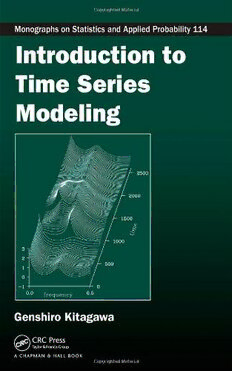Download Introduction to time series modeling, no index PDF Free - Full Version
Download Introduction to time series modeling, no index by Genshiro Kitagawa in PDF format completely FREE. No registration required, no payment needed. Get instant access to this valuable resource on PDFdrive.to!
About Introduction to time series modeling, no index
In time series modeling, the behavior of a certain phenomenon is expressed in relation to the past values of itself and other covariates. Since many important phenomena in statistical analysis are actually time series and the identification of conditional distribution of the phenomenon is an essential part of the statistical modeling, it is very important and useful to learn fundamental methods of time series modeling. Illustrating how to build models for time series using basic methods, Introduction to Time Series Modeling covers numerous time series models and the various tools for handling them. The book employs the state-space model as a generic tool for time series modeling and presents convenient recursive filtering and smoothing methods, including the Kalman filter, the non-Gaussian filter, and the sequential Monte Carlo filter, for the state-space models. Taking a unified approach to model evaluation based on the entropy maximization principle advocated by Dr. Akaike, the author derives various methods of parameter estimation, such as the least squares method, the maximum likelihood method, recursive estimation for state-space models, and model selection by the Akaike information criterion (AIC). Along with simulation methods, he also covers standard stationary time series models, such as AR and ARMA models, as well as nonstationary time series models, including the locally stationary AR model, the trend model, the seasonal adjustment model, and the time-varying coefficient AR model. With a focus on the description, modeling, prediction, and signal extraction of times series, this book provides basic tools for analyzing time series that arise in real-world problems. It encourages readers to build models for their own real-life problems.
Detailed Information
| Author: | Genshiro Kitagawa |
|---|---|
| Publication Year: | 2010 |
| ISBN: | 1584889217 |
| Pages: | 305 |
| Language: | English |
| File Size: | 3.725 |
| Format: | |
| Price: | FREE |
Safe & Secure Download - No registration required
Why Choose PDFdrive for Your Free Introduction to time series modeling, no index Download?
- 100% Free: No hidden fees or subscriptions required for one book every day.
- No Registration: Immediate access is available without creating accounts for one book every day.
- Safe and Secure: Clean downloads without malware or viruses
- Multiple Formats: PDF, MOBI, Mpub,... optimized for all devices
- Educational Resource: Supporting knowledge sharing and learning
Frequently Asked Questions
Is it really free to download Introduction to time series modeling, no index PDF?
Yes, on https://PDFdrive.to you can download Introduction to time series modeling, no index by Genshiro Kitagawa completely free. We don't require any payment, subscription, or registration to access this PDF file. For 3 books every day.
How can I read Introduction to time series modeling, no index on my mobile device?
After downloading Introduction to time series modeling, no index PDF, you can open it with any PDF reader app on your phone or tablet. We recommend using Adobe Acrobat Reader, Apple Books, or Google Play Books for the best reading experience.
Is this the full version of Introduction to time series modeling, no index?
Yes, this is the complete PDF version of Introduction to time series modeling, no index by Genshiro Kitagawa. You will be able to read the entire content as in the printed version without missing any pages.
Is it legal to download Introduction to time series modeling, no index PDF for free?
https://PDFdrive.to provides links to free educational resources available online. We do not store any files on our servers. Please be aware of copyright laws in your country before downloading.
The materials shared are intended for research, educational, and personal use in accordance with fair use principles.

